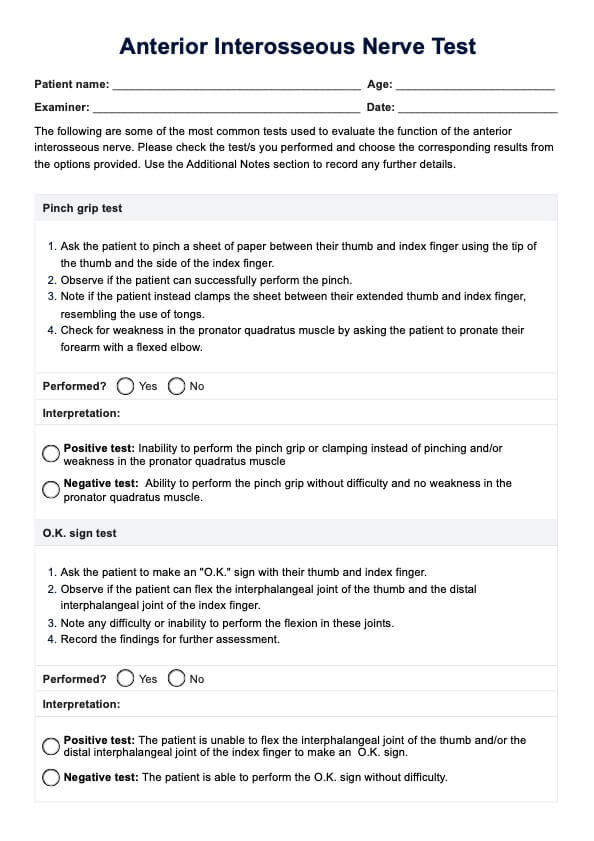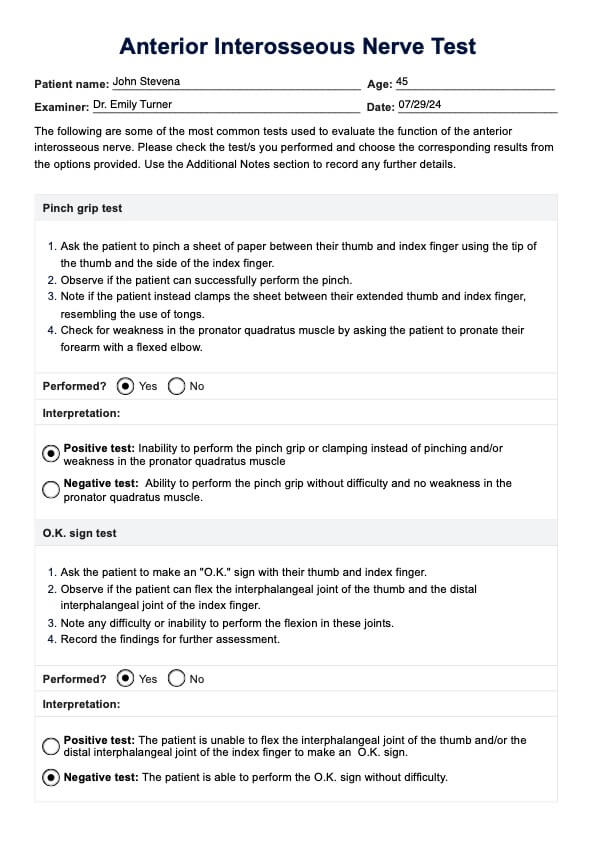Anterior Interosseous Nerve Test
Efficiently diagnose anterior interosseous nerve syndrome with our comprehensive Anterior Interosseous Nerve Test template. Download for free.


What is anterior interosseous nerve palsy?
Anterior interosseous nerve syndrome (AINS) is a rare condition characterized by motor deficits without sensory loss. AINS can be caused by compression neuropathy or brachial plexus neuritis, which leads to nerve inflammation and nerve damage. It results from the compression or injury of the anterior interosseous nerve, a branch of the median nerve that innervates specific muscles in the forearm and hand.
Typically, patients present with weakness in the thumb, index, and middle fingers, making it difficult to perform tasks that require fine motor skills, such as pinching or making an “O.K.” sign.
Diagnostic tests for anterior interosseous nerve syndrome
The diagnosis of AINS often involves clinical tests such as the pinch grip test (Froment’s sign) and the O.K. sign test. In the pinch grip test, the patient is asked to hold a piece of paper between their thumb and index finger while the examiner tries to pull it away. If the patient is unable to maintain the grip or if they flex their thumb IP joint instead of their MCP joint, it may indicate damage to AIN.
Meanwhile, in the O.K. sign test, the patient is asked to make an “O.K.” sign with their hand by touching their thumb to their index finger while extending their remaining fingers. If the patient is unable to form the shape or if they have difficulty keeping their fingertips together, it may indicate weakness in the AIN-innervated muscles.
In addition to these clinical tests, electromyography (EMG) and nerve conduction studies (NCS) can also be used to diagnose AINS. These tests involve stimulating the AIN and recording its activity in different muscles of the forearm. Abnormal results on these tests, such as reduced nerve conduction velocity or abnormal muscle activity, can indicate damage to the AIN.
Other imaging techniques, such as MRI or ultrasound, may also be used in some cases to assess the nerve and surrounding structures for any abnormalities. These tests can help identify potential causes of AINS, such as compression or entrapment of the nerve.
Anterior Interosseous Nerve Test Template
Anterior Interosseous Nerve Test Example
How to use our Anterior Interosseous Nerve Test template
Here's an easy step by step guide on using Carepatron's free and printable Anterior Interosseous Nerve Test template:
Step 1: Download the resource
Get a copy of the Anterior Interosseous Nerve Test template by downloading it from Carepatron's website. You can also use the link below to download it.
Step 2: Print or use the digital format
Once you have downloaded the template, you can either print it out or use it in digital format. Printing it out gives the advantage of filling out the information by hand, while using the digital format allows for easy editing and sharing.
Step 3: Explain how it works to your patient
Before performing the test, it is important to explain to your patient how it works and why it is being done. This helps alleviate any anxiety or confusion they may have.
Step 4: Perform the test
Follow the steps outlined in the template to perform the Anterior Interosseous Nerve Test on your patient. Make sure to document any observations or results accurately.
Step 5: Document findings
Use the Additional Notes section to document any additional findings or notes about the test. This will help provide a comprehensive overview of the patient's condition.
Step 6: Discuss results with patient
Once you have completed the test and documented your findings, discuss the results with your patient. Use this opportunity to clarify any questions or concerns they may have.
Step 7: Save for future reference
Keep a copy of the filled out template for future reference or to track any changes in the patient's condition over time.
Results and interpretations of the tests
Interpreting the results of the Anterior Interosseous Nerve Test involves assessing the outcomes of both the pinch grip test and the O.K. sign test. A positive result on either or both of these tests can indicate compression or entrapment of the anterior interosseous nerve.
A positive pinch grip test indicates weakness in the flexor digitorum profundus muscle, which is innervated by the anterior interosseous nerve. This could be a sign of compression at any point along the nerve's path, from its origin at the median nerve to its termination in the pronator quadratus muscle. Depending on the severity and location of compression, patients may experience varying degrees of weakness and pain in their forearm and hand.
Similarly, a positive O.K. sign test also indicates weakness in the flexor pollicis longus muscle, which is also innervated by the anterior interosseous nerve. This can suggest compression or entrapment at a different point along the nerve's pathway, specifically where it branches off from the median nerve. Patients may experience pain and difficulty with thumb movements due to this compression.
It is important to note that a negative result on both tests does not completely rule out compression of the anterior interosseous nerve. In some cases, there may still be mild compression that is not detectable through these tests.
How can the template benefit healthcare professionals?
Using the Anterior Interosseous Nerve Test template can provide significant advantages for healthcare professionals in their practice.
Standardized assessment
The template ensures a standardized approach to diagnosing anterior interosseous nerve syndrome, reducing variability and increasing the diagnosis's reliability. Standardized assessment for AINS is crucial for diagnosing nerve entrapment syndromes accurately.
Efficient documentation
It simplifies the process of documenting patient information and test results, ensuring comprehensive and organized patient records.
Enhanced patient communication
The template facilitates clear communication with patients by providing a structured format for explaining the tests and their outcomes, enhancing patient understanding and engagement.
Commonly asked questions
Anterior interosseous nerve syndrome is a condition characterized by paralysis of the anterior interosseous nerve, leading to weakness in the muscles it innervates, such as the pronator quadratus. This nerve runs alongside the anterior interosseous artery in the proximal forearm and is crucial for fine motor movements. When affected, patients may struggle with tasks that require precise finger and thumb movements.
The common symptoms of anterior interosseous nerve syndrome include weakness in the thumb, index, and middle fingers, difficulty performing fine motor tasks like pinching or gripping, and making an O.K. sign.
Conditions that can mimic the symptoms of anterior interosseous nerve syndrome (AINS) include carpal tunnel syndrome, flexor tendon injuries, brachial plexus injuries, and cervical radiculopathy. The pronator teres muscle can also cause entrapment of the anterior interosseous nerve, leading to similar symptoms. Accurate diagnosis often requires a combination of clinical examination and diagnostic tests like electromyography (EMG) and MRI.
The Anterior Interosseous Nerve Test assesses the function of the anterior interosseous nerve, a motor branch of the median nerve. This test is crucial for diagnosing AIN syndrome, characterized by motor deficits without sensory complaints, often presenting as forearm pain and weakness in the thumb and index finger pincer movement.







































































































